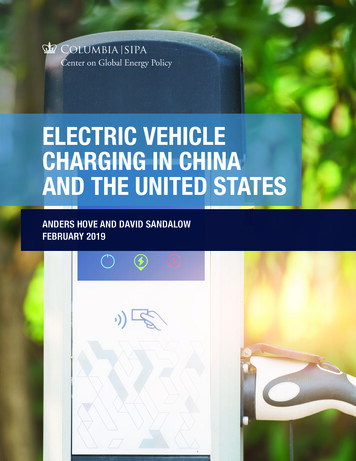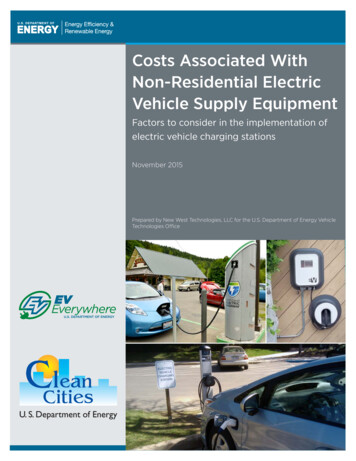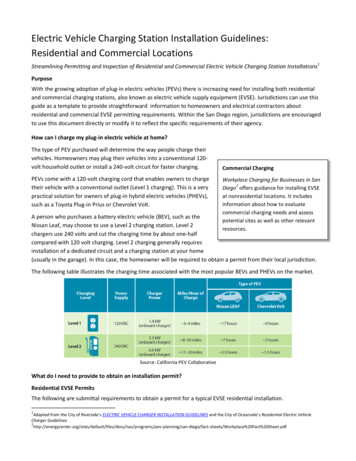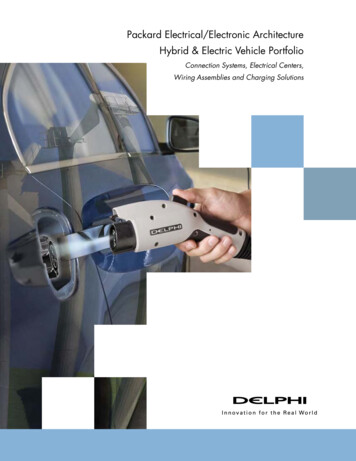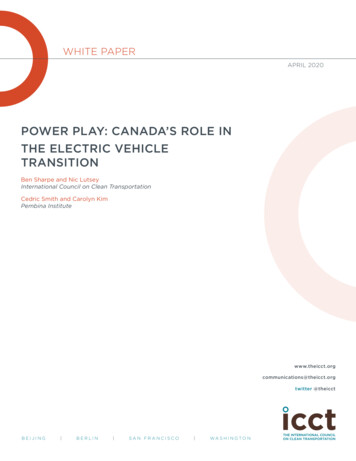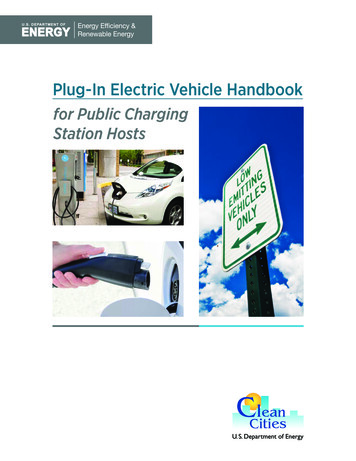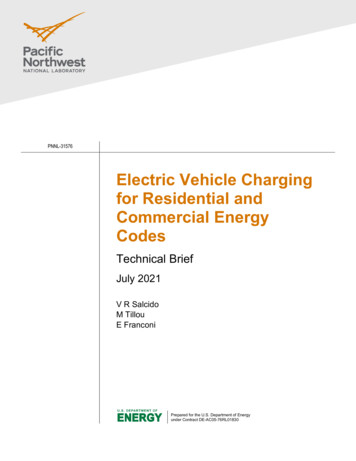
Transcription
PNNL-31576Electric Vehicle Chargingfor Residential andCommercial EnergyCodesTechnical BriefJuly 2021V R SalcidoM TillouE FranconiPrepared for the U.S. Department of Energyunder Contract DE-AC05-76RL01830Choose an item.
DISCLAIMERThis report was prepared as an account of work sponsored by an agency of theUnited States Government. Neither the United States Government nor any agencythereof, nor Battelle Memorial Institute, nor any of their employees, makes anywarranty, express or implied, or assumes any legal liability or responsibilityfor the accuracy, completeness, or usefulness of any information, apparatus,product, or process disclosed, or represents that its use would not infringeprivately owned rights. Reference herein to any specific commercial product,process, or service by trade name, trademark, manufacturer, or otherwise does notnecessarily constitute or imply its endorsement, recommendation, or favoring bythe United States Government or any agency thereof, or Battelle MemorialInstitute. The views and opinions of authors expressed herein do not necessarilystate or reflect those of the United States Government or any agency thereof.PACIFIC NORTHWEST NATIONAL LABORATORYoperated byBATTELLEfor theUNITED STATES DEPARTMENT OF ENERGYunder Contract DE-AC05-76RL01830Printed in the United States of AmericaAvailable to DOE and DOE contractors from theOffice of Scientific and Technical Information,P.O. Box 62, Oak Ridge, TN 37831-0062;ph: (865) 576-8401fax: (865) 576-5728email: reports@adonis.osti.govAvailable to the public from the National Technical Information Service5301 Shawnee Rd., Alexandria, VA 22312ph: (800) 553-NTIS (6847)email: orders@ntis.gov https://www.ntis.gov/about Online ordering: http://www.ntis.govChoose an item.
PNNL-31576Electric Vehicle Charging for Residential andCommercial Energy CodesTechnical BriefJuly 2021V R SalcidoM TillouE FranconiPrepared forthe U.S. Department of Energyunder Contract DE-AC05-76RL01830Pacific Northwest National LaboratoryRichland, Washington 99354
PNNL-31576PreambleThe U.S. Department of Energy (DOE) and Pacific Northwest National Laboratory (PNNL) aredeveloping a series of technical briefs supporting national, state and local initiatives to updateand advance building energy codes. These technical briefs represent specific technologies,measures or practices that can be incorporated as module-based “plug-ins” via the nationalmodel energy codes, such as the International Energy Conservation Code (IECC) or ASHRAEStandard 90.1, or adopted directly by state and local governments pursuing advanced energysavings and greenhouse gas (GHG) emissions reductions. The collection of technical briefs ispart of a larger effort to provide technical assistance supporting states and local governments inorder to help them realize their policy goals.This technical brief presents a compilation of information on electric vehicles (EVs), examiningmarket trends, benefits to consumers and society, and means of expanding the EV charginginfrastructure by way of energy codes for new construction. A description of the concept isprovided along with supporting justification and examples of similar concepts which have beenadopted by states and local jurisdictions, as well as technical information on expected costs andbenefits. In addition, the brief provides sample energy code language developed by PNNLfollowing consultations with the International Code Council (ICC) that can be overlaid directlyonto model energy codes for EV charging infrastructure (Section 3). A technical brief is intendedto be a resource for interested and affected stakeholders, particularly those charged withconsidering the impacts of proposed code updates.Additional assistance may be available from DOE and PNNL to support states and localgovernments who are interested in adding EVs and other “stretch” provisions to their buildingcodes, such as technical guidance, customized analysis of expected impacts (e.g., based onstate-specific building stock, climate considerations or utility rates), and further tailored codelanguage to overlay state building codes or other standards. DOE provides this assistance inresponse to the Energy Conservation and Production Act (ECPA), which directs the Secretaryof Energy to provide technical assistance “to support implementation of state residential andcommercial building energy efficiency codes.” (42 USC 6833) PNNL supports this mission byevaluating concepts for future code updates, conducting technical reviews and analysis ofpotential code changes, and providing assistance to states and local jurisdictions who strive toadopt, comply with and enfoce energy codes. This helps to ensure successful implementation ofbuilding energy codes, as well as a range of advanced technologies and construction practices,and encourages building standards which are proven practical, affordable and efficient.DOE Building Energy Codes ProgramThe U.S. Department of Energy supports the advancement of building energy codes. Modernbuilding codes and standards offer cost-effective solutions, contributing to lower utility bills forhomes and businesses, and helping to mitigate the impacts of climate change. Learn more atenergycodes.gov.iii
PNNL-31576Executive SummaryNumerous studies show that sales of electric vehicles (EVs) have grown consistently overrecent years in the U.S. Edison Electric Institute (EEI) estimates one million EVs on the road in2018 and forecasts a total of 18.7 million EVs on the road by 2030. Based on this forecast, EEIprojects the need for an additional 9.6 million EV charging stations by 2030. It is imperative thatthe EV charging infrastructure keeps pace with sales of EVs to to enhance overall EV growth,and to ensure that lack of access to EV charging stations is minimized as a critical barrier to EVadoption.EVs provide substantial benefits to the consumer and society. EVs are less expensive tooperate than conventional gas vehicles, have lower maintenance costs, and have theconvenience of fueling (charging) at home or work. EVs likewise reduce GHG emissions. EVmarket growth combined with a cleaner grid will support goals of reduced GHG emissionsestablished across the U.S. and others by federal agencies, as well as many states and localgovernments. According to the U.S. Environmental Protection Agency (EPA), the transportationsector (cars, trucks, trains, ships, airplanes, and other vehicles) accounts for 29% of total U.S.GHG emissions. Globally, road travel accounts for 75% of transportation emissions. Studiesconducted in California show that costs associated with installing EV charging infrastructure canbe substantially more expensive for retrofit scenarios compared to new construction.Many states and local governments have added EV provisions to their building codes, localordinances and zoning requirements. This technical brief summarizes current market trends,costs and benefits, and provides sample code language for EV charging infrastructure forinclusion in future model codes, such as the International Energy Conservation Code (IECC)and ASHRAE Standard 90.1, as well as directly by states and local governments in theirbuilding codes. The current brief summarizes related efforts undertaken by states and localgovernments, and builds upon language considered for the 2021 IECC 1, and includes additionalrequirements developed by both PNNL staff and ICC staff. The Code Council is developing anadditional resource considering multiple approaches to EV charging infrastructure and recentlyreleased a public review draft for comments 2. Comments on that resource are due August 16,2021.12A similar concept was originally approved for inclusion in the 2021 IECC but removed upon appeal.www.iccsafe.org/energy/EVresourceiv
PNNL-31576ContentsPreamble .iiiExecutive Summary . iv1.0Electric Vehicle Charging in Residential and Commercial Energy Codes. 11.1Consumer and Societal Benefits . 21.2EV Market Trends . 41.3EV Charging . 51.4EV Charging Infrastructure . 61.5Existing EV Charging Requirements in Energy Codes. 82.0Economic Analysis . 123.0Sample Code Language . 154.03.1Definitions . 153.2Residential Buildings . 153.3Commercial Buildings . 17References . 20FiguresFigure 1.Total U.S. Greenhouse Gas Emissions by Economic Sector in 2019 (6,558MT CO2) . 3Figure 2.EV Stock Forecast to 2030 . 4Figure 3.EV Sales Forecast . 5Figure 4.EV Charge Time Based on EV Charging Power . 6Figure 5.EV Charging Infrastructure in 2030 Based on the EEI Forecast . 7Figure 6.Options for EV Infrastructure Requirements . 8Figure 7.Cost Breakdown of EV Charging for New Construction and Retrofit . 13TablesTable 1. Cities with EV Charging Infrastructure Requirements . 10Table 2. Cost of EV Charging Infrastructure . 12Table 3. Cost of EV Charging Infrastructure – Single Family . 13v
PNNL-315761.0 Electric Vehicle Charging in Residential andCommercial Energy CodesThe electric vehicle market is growing dramatically and emerging as the future of transportation.In the U.S., EV sales increased 80% from 2017 to 2018 (Edison Electric Institute). In fact, EVsales in the U.S. reached a new milestone in 2021. The Bureau of Transportation Statistics(BTS) indicated EV sales reached more than 120,000 in March 2021 marking an overall recordhigh in EV sales. 3 BTS data indicate that EV sales have been growing consistently for the past12 months. While EVs represent less than 0.5% of vehicles on the road in the U.S., thatpercentage is expected to reach 7% in 2030 and this demand necessitates expanding EVcharging infrastructure.Approximately half of all vehicles in the U.S. belong to residents of single-family or duplexhomes that have access to a dedicated off-street parking space, such as a garage or driveway,which can typically be used for overnight EV charging. New homes are built to last for decades,thus they represent a unique opportunity to be equipped to handle future technologies, includingthe ability to charge EVs. As half of vehicles in the U.S. do not have reliable access to dedicatedoff-street parking, the EV market must move beyond single-family detached homes and expandEV charging access in other feasible locations, such as multifamily unit dwellings, workplaces,and commercial properties. EV-ready building codes support this expansion and can saveconsumers thousands of dollars in installation costs when included in initial construction. 4Incorporating EV requirements into building codes is an effective and low-cost strategy thatsupports local and state efforts to reduce carbon emissions and achieve a clean resilient grid.Doing so also supports future efforts to use battery storage to manage utility peak demand. Thisincludes using EVs as a distributed energy resource and realizing vehicle-to-grid integration(VGI), where bidirectional chargers allow electricity to flow from the electric vehicle back to thegrid. Thus in the near future, EVs will provide added value to the grid and to car owners withoutthe outlay of new capital. According to E3, the expected additional revenue to the consumer is 345/year for managed unidirectional charging that ramps up and down. The additional benefitsof VGI resulting from other grid services, such as frequency regulation, increase the value byabout 500 per year. 5The concept of incorporating EV charging infrastructure into the model codes was considered,and initially approved, for the 2021 International Energy Conservation Code (IECC), but laterremoved in response to appeals. 6 DOE, the International Code Council (ICC), and otherinterested stakeholders have coordinated to update the concept such that it could be considereddirectly by states and local governments interested in adopting EV provisions into their codes,as well as for future model code development via the IECC. The EV charging infrastructurerequirements included in this technical brief build upon the language considered for the 2021IECC, and adds further information, analysis and suggested code language as developed byPNNL and ICC staff. These model requirements are intended to support consistency inapproach and provide a degree of certainty for building owners, designers, contractors,manufacturers and building and fire safety professionals., As each State and municipality e-code-on-ev-ready-building-codes5 GI 4.12-Slides.pdf.6 nand-improvement/41
PNNL-31576different the recommended number of required spaces designed with EV charging infrastructureincluded in the model code language should be adjusted to reflect the local needs of yourjurisdiction. Feedback is actively being sought on this proposal, and both DOE and ICC areevaluating ways to engage interested and affected stakeholders to coordinate a final concept inthe coming months. The Code Council is developing an additional resource considering multipleapproaches to PEV charging infrastructure and recently released a public review draft forcomments. 7 Comments on that resource are due August 16, 2021.1.1 Consumer and Societal BenefitsAccording to the U.S. Environmental Protection Agency (EPA), the transportation sector (cars,trucks, trains, ships, airplanes, and other vehicles) accounts for 29% of total U.S. greenhousegas (GHG) emissions. 8 Figure 1 shows the total GHG emissions by sector. Globally, road travelaccounts for 75% of total transportation emissions. 9 Increasing EV sales now and thoseprojected by 2030 will help reduce U.S. GHG emissions produced by moving goods and people.DOE will support the growth of the EV market to meet its objective of reduced GHG emissions.GHG emission reductions derived by using EVs in the U.S. will continue to improve as theelectric grid becomes cleaner. EVs charged exclusively by renewable energy will run emissionfree.The manufacturing and sales of EVs, hybrids, and plug-in hybrids supported 266,384 jobs in theU.S. in 2019, representing 10% of the total motor vehicle workforce. Furthermore, alternativefuel vehicle jobs have grown 39% since 2015 and auto manufacturers and component partsemployers anticipate a job growth rate of 3.0% in 2020. 10 The projected growth in demand forEV and EV infrastructure will continue to support future job growth in alternative fuel vehiclerelated ions#transportation9 92230956175/USEER 2020 0615.pdf82
PNNL-31576Source: U.S. Environmental Protection Agency – Sources of GHG EmissionsFigure 1. Total U.S. Greenhouse Gas Emissions by Economic Sector in 2019 (6,558 MT CO2)EVs benefit the consumer through lower operational and maintenance costs. It is cheaper tofuel an EV; its fuel efficiency is equivalent to up to 100 miles per gallon for a gas-poweredvehicle. 11 This translates to an annual average cost savings of 800. In addition, EVs have nogasoline engine, oil, spark plugs, or timing belts that require annual maintenance, and electricengines require little to no maintenance, which translates into additional average annual savingsof around 1,500. 12EVs provide an enhanced driving experience over gas-powered vehicles with silent drive andinstant torque that provides smooth and quick acceleration. EVs also provide convenience byfueling at home or work rather than driving to a gas station.Finding the nearest charging station is becoming easier with new EV charging applications. Inaddition to numerous online resources, the United States Department of Energy AlternativeFuels Data Center maintains a comprehensive station locator for the United States and Canada.Each station location includes information about the business where the station is found,charging speeds, and port types. 1311https://afdc.energy.gov/fuels/electricity d113 https://afdc.energy.gov/stations/#/find/nearest123
PNNL-315761.2 EV Market TrendsAll reports of EV purchases show record sales and a growing market illustrating that EVs arethe future of transportation. Over 1 million EVs are on U.S. roads as of October 2018. 14 By2030, EEI forecasts the number of EVs on the road to reach 18.7 million. This representsapproximately 7% of the 259 million vehicles on the road in the U.S. Figure 2 and Figure 3 showthe EV stock forecast and EV sales forecast as a percentage of all vehicle sales, respectively14.All major auto manufacturers have announced plans to electrify a significant portion of theirvehicle fleets over the next 3–5 years.14 The interest in EVs has grown together with greatermodel availability and increased vehicle range. The success of the EV market is directlyrelated to the availability of the EV charging infrastructure in private and public settings. It isvitally important to increase the amount of EV charging stations to support the transition toEVs.Source: Edison Electric Institute 2018Figure 2. EV Stock Forecast to es/IEI/publications/IEI EEI-EV-ForecastReport Nov2018.ashx4
PNNL-31576Source: Edison Electric Institute 2018Figure 3. EV Sales Forecast1.3 EV ChargingIn order to fuel a EV, a connection to the grid or power source is required in the form of acharging station also known as electric vehicle supply equipment (EVSE). EVSEs come in avariety of configurations but are typically separated by power level. There are three levels ofESVE: Level 1, Level 2, and DC Fast Charging (DCFC). Level 1: Level 1 charging uses a common 120-volt household outlet. Every electric vehicleor plug-in hybrid can be charged on Level 1 by plugging the charging equipment into aregular wall outlet. Level 1 is the slowest way to charge an EV. It adds between 3 and 5miles of range per hour. Level 1 EV charging stations are located typically at home,workplace or public parking 15. Level 2: Level 2 charging is the most widely used level for daily EV charging. Level 2 ESVEcan be installed at home, at the workplace, as well as in public locations like shoppingplazas, train stations, and other destinations. Level 2 charging can replenish between 12and 80 miles of range per hour, depending on the power output of the Level 2 charger, andthe vehicle’s maximum charge rate. 16 DC Fast Charging (DCFC): DCFC (sometimes referred to as Level 3) is the fastest type ofcharging available and can recharge an EV at a rate of 3 to 20 miles of range per minute (or180 to 1,200 miles of range per hour). Unlike Level 1 and Level 2 charging that usesalternating current (AC), DCFC charging uses direct current (DC). The voltage is also much1516https://afdc.energy.gov/fuels/electricity lectricity infrastructure.html5
PNNL-31576higher than Level 1 and 2 charging, which is why you don’t see DCFC chargers installed athome. Very few residential locations have the high-voltage supply that is required for DCFCcharging.16According to JD Power’s U.S. Electric Vehicle Experience (EVX) Home Charging Study, 88% ofEV-owners prefer to charge their vehicle at home where charging can take place overnight. 17Installment of Level 2 or DCFC EVSE at workplaces or in public settings allows EV-owners todrive more miles on electricity and enables longer trips while reducing range anxiety. 18 Figure 4compares EV charge time based on EV charging level.Source: Mckinsey & Company – charge-the-electric-vehicle-marketFigure 4. EV Charge Time Based on EV Charging Power1.4 EV Charging InfrastructureAs mentioned earlier, EEI forecasts the number of EVs on U.S. roads to reach 18.7 million by2030.2 To support this growth, an additional 9.6 million EV charging stations will be required by2030. This includes 9.5 million Level 2 public and private charging stations and 0.1 million Level3 public fast charging stations. Given the extensive charging time of a Level 1 ESVE, Level 2chargers are currently prioritized as the solution until newer and more advanced residentialcharging methods are available. Figure 5 shows the projected mix of EV charging stationsneeded by ty t/-/media/Files/IEI/publications/IEI EEI-EV-ForecastReport Nov2018.ashx186
PNNL-31576Source: Edison Electric Institute 2018Figure 5. EV Charging Infrastructure in 2030 Based on the EEI ForecastThe availability and ease of access to Level 2 and DCFC EVSE is a critical barrier to EVadoption. 19 A lack of pre-existing EV charging infrastructure, such as electrical panel capacity,raceways, and pre-wiring, can make the installation of a new charging station cost-prohibitive fora potential EV-owner 20.State and local governments around the country have led the way on EV-Ready BuildingCodes, with requirements that have been adapted to best fit the needs of each community.Three basic options for EV infrastructure requirements are shown in Figure 6Figure 6. For oneand two-family dwellings with dedicated off-street parking, Level 2 EV-capable or EVSE-Readyoutlet provisions are required for at least one parking space per residence. For multifamilydwellings and commercial properties, EV charging infrastructure requirements are applied as apercentage of total parking spaces (e.g., 5% of total parking spaces are to be EV-capable forparking lots with over 10 parking spaces). 21The DOE Alternative Fuel Data Center provides additional resources to support thedevelopment of EV charging infrastructure. Resources include procurement and installationchecklists, operation and maintenance costs, and access to the EVI-Pro Lite Tool, which canhelp jurisdictions identify the number and type of EV charging stations required for their area. 898.pdfFrancfort et al. 201521 eady-building-codes22 https://afdc.energy.gov/fuels/electricity infrastructure development.html207
PNNL-31576Source – Southwest Energy Efficiency Project 2018Figure 6. Options for EV Infrastructure Requirements1.5 Existing EV Charging Requirements in Energy CodesThis section highlights some of the various approaches to EV-integrated building codes that areharnessed by different local governments in more depth. Table 1, incorporated below, highlightssample EV infrastructure code provisions that are currently implemented across North America.These approaches can influence future code adoption for local jurisdictions seeking to meetGHG reduction targets.International Green Construction Code – Model CodeThe 2021 International Green Construction Code (IgCC) includes the following requirements forthe installation of EVSE:501.3.7.3 Electric vehicle charging facilities.Where 20 or more on-site vehicle parking spaces are provided for International Building Code(IBC) Occupancy Group A, B, E, F, I, M, and S buildings, not less than 4% of the total number ofparking spaces or not less than 8% of designated employee only parking spaces shall be EVReady spaces. Where 10 or more on-site vehicle parking spaces are provided for IBCOccupancy Group R-1, R-2, and R-4 buildings, not less than 20% of the total number of parkingspaces shall be EV-Ready spaces. The required number of EV-Ready spaces shall be roundedup to the next highest whole number.California – State LevelCalifornia set ambitious targets for ZEH charging infrastructure to support their mission ofhaving 5 million ZEHs by 2030. The state plans to install 250,000 shared plug-in electric vehiclechargers, including 10,000 DCFCs and 200 hydrogen stations by 2050. The 2020 CaliforniaGreen Building Code’s (CALGreen) includes provisions for EV infrastructure requirements innew multifamily, residential and non-residential buildings, as well as stretch code requirements.8
PNNL-31576Local governments can adopt or surpass the CALGreen stretch codes for EV-Capable or EVReady spaces, although it is not required.CALGreen requires new construction of multi-unit dwellings to include EV-Capableinfrastructure in at least 10 percent of parking spaces. The two-tiered reach codes enable citiesto adopt requirements for EV-Capable infrastructure in 15 percent or 20 percent of multi-unitdevelopment (MUD) parking spaces. CALGreen has also established requirements for newconstruction single-family residences, duplexes and townhouses with private garages. Theresidential provisions require EV-Capable capacity to support Level-2 charging stationinstallations. CALGreen also requires new construction non-residential buildings to have 6percent of parking spaces EV-Capable, with reach codes supporting 8 percent and 10 percentcapacity.Local governments have shown support of the CALGreen EV infrastructure building coderequirements, with 20 jurisdictions exceeding the minimum code requirements in their local codeadoptions. Some municipalities are also implementing parking ordinances to encourage theinstallation of EV charging stations, specifically for new construction. Some jurisdictions havegone even farther to explore adoption of EV infrastructure codes that address existing buildingsincluding the City of Marin, City of Menlo Park, and the City and County of San Francisco. Suchstretch codes target alterations and additions to provide opportunities for EV infrastructureinstallation in existing buildings. 23Denver, Colorado – City LevelDenver, Colorado amended the 2018 IECC and IRC to include the following EV charginginfrastructure requirements to meet its goal of electrifying 30% of all vehicles by 2030:One- and two-family dwellings: At least one EV-Ready parking space per dwelling unit.Multi-family dwellings (3 dwellings) with 10 spaces: 5% of parking spaces to be EVInstalled, 15% EV-Ready Parking Spaces, and 75% EV-Capable Parking Spaces.Commercial buildings (Groups A, B, E, I, M, S-2) with 10 spaces: 5% of parking spaces tobe EV-Installed, 10% EV-Ready Parking Spaces, and 10% EV-Capable Parking Spaces.Building Alterations: ‘Level-3 Alterations’, where the work area exceeds 50 percent of theoriginal building area or more than 10 parking spaces are substantially modified, are subject tothe EV infrastructure requirements for both residential and commercial buildings.DC Fast-charger provision: For MUD and Commercial buildings, allow developers tosubstitute up to five Level-2 charging spaces with one DC fast-charging space (minimum20kW). 24Winter Park, Florida – City LevelThe City of Winter Park adopted an EV-Readiness Ordinance that amends both its LandDevelopment Code and Building Code. Winter Park amended Section 58-86 “Off-street Parking23California Governor’s Office of Business and Economic Development, “Electric Vehicle ChargingStation Permitting Guidebook,” (First Edition: July 2019).24 City of Denver Community Planning and Development, “Code Amendment Proposal,” (2019).9
PNNL-31576and Loading Regulations” of its Land Development Code to include EV charging stationinfrastructure and parking space requirements. Under this amendment, non-residentialproperties with surface parking or parking structures are required to have a minimum of 10percent of total parking spaces to be Level-2 EV-Ready. The EV charging infrastructure isrequired to be installed in accordance with the technical amendment made to the FloridaBuilding Code (Chapter 22, Section 2703 of the City of Winter Park Code of Ordinances). TheLand Development Code amendment also requires non-residential properties to provide, atminimum, 1 parking space equipped with a Level-2 EV charging station per every 20 requiredoff-street par
costs and benefits, and provides sample code language for EV charging infrastructure for inclusion in future model codes, such as the International Energy Conservation Code (IECC) and ASHRAE Standard 90.1, as well as directly by states and local governments in their building codes.
